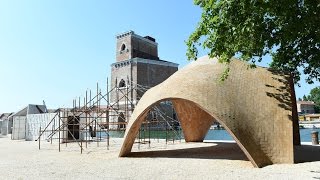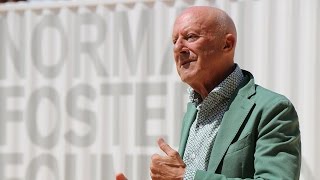“Learning in architecture comes very much from examples”
Alejandro Aravena on the interaction between architecture and industry: The Droneport project
-
1 / 5
“The construction industry needs to engage with the growing demand for sustainable construction; and have the knowledge and the tools to live up to it” - Alejandro Aravena, Curator of the 15th International Architecture Exhibition of La Biennale di Venezia and Member of the Board of the LafargeHolcim Foundation.
-
2 / 5
Board of the Foundation meets at the Venice Biennale
The highlight of the guided tour was the visit of the prototype of the Droneport shell at La Arsenale. Initiated by The Norman Foster Foundation, the project brought together professors and students from five universities across Europe, the UK and America along with the Swiss LafargeHolcim Foundation for Sustainable Construction and its related Research Center in Lyon.
The LafargeHolcim Foundation is forging partnerships that promote sustainable construction and life cycle thinking along the value chain from design through to implementation. The Foundation’s approach of learning from outstanding examples is aligned with the International Architecture Biennale – the most important exhibition of its kind, which attracts thousands of the world’s most influential architects, designers, urban planners, developers and critics.
Last updated: September 06, 2016 Venice, Italy
The LafargeHolcim Foundation is forging partnerships that promote sustainable construction and life cycle thinking along the value chain from design through to implementation. The Foundation’s approach of learning from outstanding examples is aligned with the International Architecture Biennale – the most important exhibition of its kind, which attracts thousands of the world’s most influential architects, designers, urban planners, developers and critics.
Curator of the 15th International Architecture Biennale, Alejandro Aravena, supports using “a mix of high-tech innovation and low-tech local materials” to reduce carbon emissions related to construction. In a video released by the LafargeHolcim Foundation for Sustainable Construction, Aravena points to the Droneport shell prototype at the Venice exhibition as an outstanding example of the pivotal change needed from architecture and industry. The project combines state-of-the art technology and traditional materials to create a self-supporting structure using compressed-earth bricks.
 Innovation and creativity to move the industry ahead
Innovation and creativity to move the industry ahead
One of the main goals of the Biennale “Reporting from the Front” is to share practical ideas because “learning in architecture comes very much from examples”, says Aravena (video, right). The Biennale strives to bring together technical innovation (“crucial because in the end it’s about ideas being translated into reality”) and creativity to show means and ways to improve the quality of life in the built environment.
“The construction industry needs to engage with the growing demand for sustainable construction; and have the knowledge and the tools to live up to it”, adds Aravena, winner of the Pritzker “Nobel Prize” for Architecture. “We must realize that our business is full of constraints, we need to be very clear about what is possible and what is not”. For Aravena, this is the trigger for creativity and emphatically requires a closer collaboration between designers, engineers and the construction materials industry to “move ahead and make a change”.
 Compressed earth bricks form self-supporting vaulted structure
Compressed earth bricks form self-supporting vaulted structure
This “change-making” mindset is exemplified by the Droneport project (video, right) at the Architecture Biennale that was initiated by The Norman Foster Foundation. The project brought together professors and students from five universities across Europe and the US along with the LafargeHolcim Foundation for Sustainable Construction and the LafargeHolcim Research Center in Lyon.
Based on the requirements of the design by Lord Norman Foster (video, below right) and the engineers of Ochsendorf DeJong & Block (ODB), the Lyon Research Centre optimized the mix of earth-based Durabric for the project. 18,000 customized bricks were produced for the Droneport shell in cooperation with the Block Research Group at ETH Zurich. The challenge was to ensure a compressive strength of at least 10MPa whilst minimizing the weight and thickness of each tile. Although initially developed as a solution for the Droneport, the construction system is applicable to a wider range of needs – markets, schools and medical facilities, for example.
 Durabric is made of stabilized earth – a reliable, affordable and environmentally friendly building material, particularly suitable in emerging countries. LafargeHolcim initiated commercial production of the naturally cured building block that uses locally sourced compressed earth and achieves impressive structural strength through the addition of cement. LafargeHolcim recently launched “14Trees” to support the use of Durabric for affordable housing projects – a joint venture with CDC, the UK’s development finance institution.
Durabric is made of stabilized earth – a reliable, affordable and environmentally friendly building material, particularly suitable in emerging countries. LafargeHolcim initiated commercial production of the naturally cured building block that uses locally sourced compressed earth and achieves impressive structural strength through the addition of cement. LafargeHolcim recently launched “14Trees” to support the use of Durabric for affordable housing projects – a joint venture with CDC, the UK’s development finance institution.

